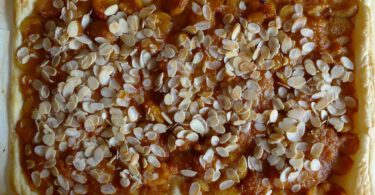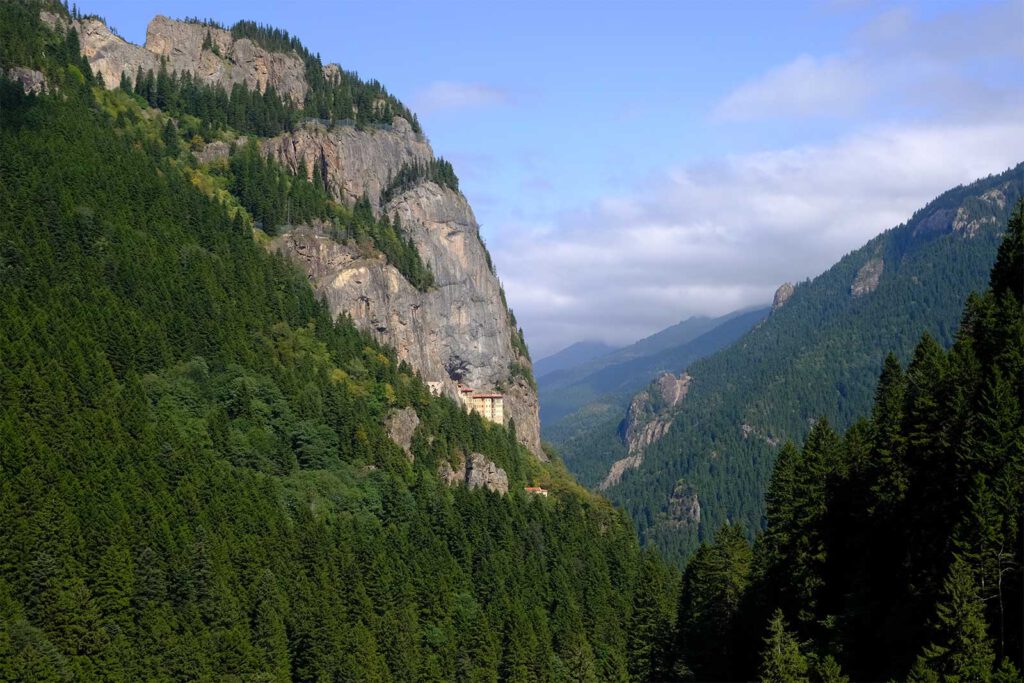
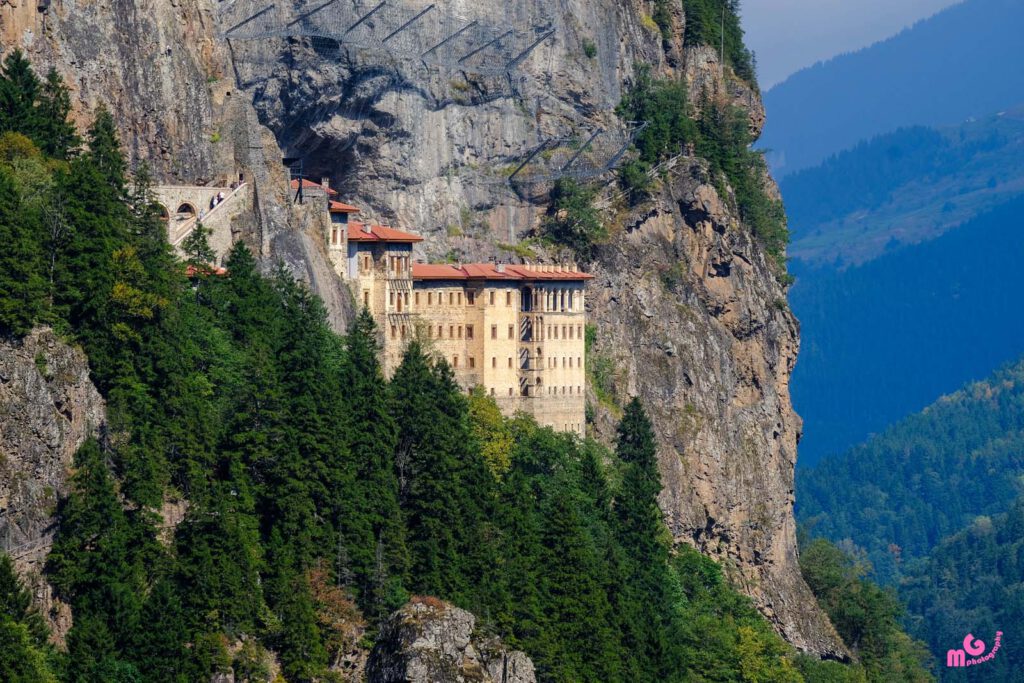

Editorial
I am well known in the culinary world for my essays. Since a few years I write about this topic in my travel journals. We all want to enjoy good cuisine when we are travelling.This time I am interested in simple food, regional, honest, real!
In the high regions of the Black Sea- Mountains(Turkish: Kaçkar Dağlar) , people like to eat solid food.
The dishes are “alpine” in character, adapted to the lonely life on the mountain farms.
Milk and dairy products, cereals and pastries.
You can get wonderful cheese there.
For breakfast, people like to eat a tasty “muhlama”.
First, a roux is prepared from maize flour, butter and water. The mixture is then refined with cheese, in principle nothing more than a fondue, although the latter does not require roux.
The yoghurt in Turkey is top class, everyone knows that!
I was thrilled by the Turkish bread in all its variations, there is a large selection, much larger than one would imagine
Corn bread with a crispy crust, large white breads made from excellent flour, traditionally and by hand in the local bakeries. A tempting aroma rises to the nose when fresh bread is baked somewhere.
Top patissiers in the West trust the hazelnut from Piedmont. However, I can assure you that I have been served several sweet pastries with Turkish hazelnut that have convinced me. Some of them even with a hint less sugar, which they love there, as we all know.
Fish is a big topic, anchovies are popular nationwide. There are trout in the mountain valleys. The fish is usually pan-fried until crispy, which is how the people there like it best.
The focus of the journey is the Çay, about which the reader soon learns more.
Real gourmandise is called for in the tea tasting, a serious matter in which the taste senses must be sharpened.
Years of routine in competitions, countless culinary tastings and many restaurant visits help, of course.
I love Turkish tea! As soon as I landed in Germany, I got the necessary Çay equipment for little money from the Turkish merchant next corner.
Since then, it’s hard to imagine our household without it.
The Çay tastes discreetly aromatic, does not contain so much caffeine and ” settles wonderfully in the stomach”.
Friendly people, good cuisine and an exotic landscape.
Please do not expect detailed tasting notes in this report, it is about nature, its inhabitants and its history.
Perhaps I can arouse a little curiosity in you about this green country far away from the usual mass tourism.
All the best,
Yours Mathias Guthmann
The Turkish Black Sea coast has recently turned into a fantastic travel destination.
While the Mediterranean hotspots are famous for their beautiful beaches, Istanbul cultivates its cosmopolitan flair, the West lures with the marvels of antiquity, the Black Sea coast is convincing with its generous nature.
Everywhere it grows and thrives, a green land with bizarre rock formations, gushing waterfalls, clear rivers, ancient monasteries and hidden mountain villages.
Çay, the Turkish tea, covers the mountain slopes and so it sometimes seems to the visitor that he is travelling somewhere in China or India, an enchanting fata morgana
We are in a wild nature largely spared from mass tourism!
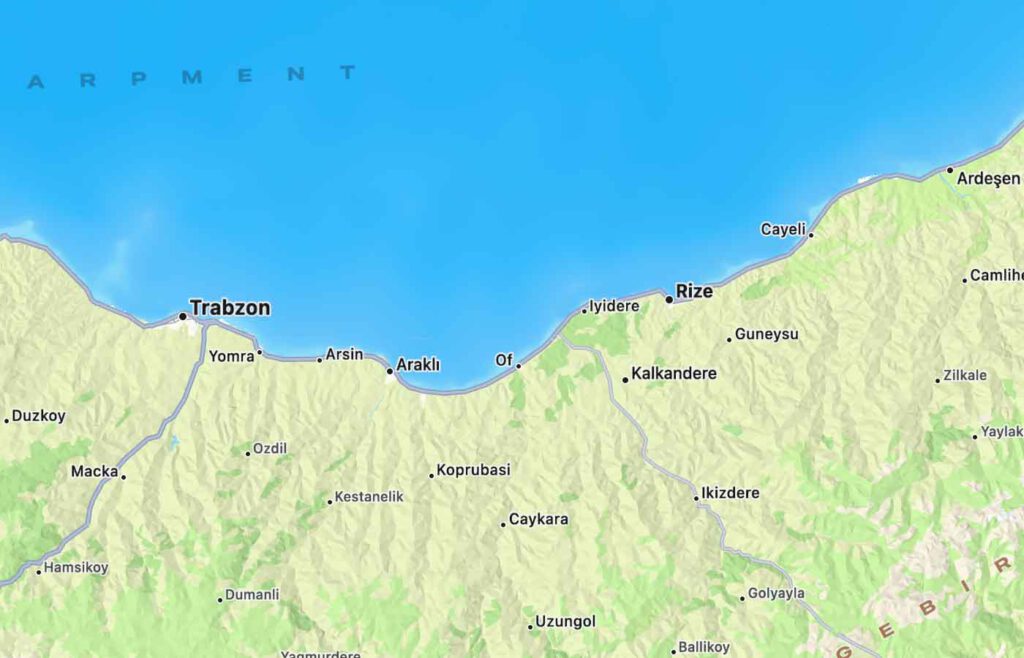
In Trabzon, the major provincial capital, I meet colleagues from Belgium, Poland and Bulgaria.
Together, over the next few days, we want to uncover the secret of Çay, the favourite drink of all Turks.
An interesting and friendly group of journalists is meeting, invited by GoTürkiye, the large agency that strengthens and promotes local tourism potential together with the TGA.









Sümela
The first destination is the Sümela Monastery in the Black Sea Mountains (Turkish: Kaçkar Dağlar), situated at an altitude of almost 1100 metres in a breathtakingly beautiful location.It is about an hour’s drive from Trabzon. You can either hire a car, which requires a high level of driving skills, or take a guided tour.
A colourful legend revolves around the founding of the monastery. Two angels are said to have carried an icon of our holy virgin mary painted by the evangelist Luke into the Black Sea Mountains (Turkish: Kaçkar Dağlar).
Barnabas and Sophronius, two itinerant monks from Athens, discovered the image and decided to build a chapel on the same spot.
The episode is said to have taken place in 385 AD, even then the area was sparsely populated.
The oldest preserved buildings date from the Comnenian period and date to the 14th century, the time of the Empire of Trapezunt under Alexios III.
Even after the Ottoman conquest in 1461, the monastery remains and becomes an important place of pilgrimage.
The interior and exterior walls of the rock church are decorated with frescoes from the time of Alexios III. Not everything has been preserved, these are the ravages of time!
The frescoes show biblical scenes, portraits of Alexios and Manuel were once present, but have not survived the ages.
It was in late Ottoman times, in the 19th century, when the monastery acquired its present appearance.
Sümela has maintained an extensive library over the centuries. Some of the manuscripts can be seen in Ankara.
Many so-called Tetraevangelia (the four evangelists) from Byzantine times are in the Hagia Sophia in Istanbul.
Tipp: Contact the reception desk directly at your hotel. In Trabzon, there are good offers for excursions to Sümela in different price categories. You can also book conveniently on the GetYourGuide platform, which has the advantage of being able to plan earlier.

Trabzon
The historic district of Orta Malhalle in Trabzon offers magnificent views over the city and the sea.
You can also visit a number of exceptionally beautiful houses built in the 19th century by wealthy Turkish businessmen. During the Russian occupation in World War I, the owners fled. In 1918, the Russians leave the city again, which leads to the Greek population coming under pressure. Turkish units secure control of the city.
However, they did not want to surrender completely without a fight and even founded a Greek independence movement, but the cards were finally reshuffled in the Greek-Turkish War (1919-1922), from which Greece emerged as the loser.
The Greek population was resettled, leaving only Greeks who had converted to Islam.
Today, the neighbourhood is urbanised, you stroll through the pretty alleys and recover a little from your exertions in one of the nice local cafés.

















The photo shows Isgüzar Karagöz, an excellent artist whose work is known beyond the borders of Trabzon.
Some of her imaginative ceramics are truly spectacular. Karagöz not only enjoys a reputation as a master of her craft, but has trained over 3500 pupils and students in her long career.
She has received several awards and has participated in numerous international exhibitions.







The Empire of Trebizond and the Hagia Sophia
Trebizond, a name that sounds like something out of a tale from the 1001 Nights.In contrast to the fantastic stories of Sheherazade, however, Trebizond once was a flourishing empire that emerged after the end of Constantinople in 1204, when Venetians and Crusaders occupied the city and proclaimed the Latin Empire.
The chronicler Niketa Choniates writes about Constantinople before this world-historically decisive conquest:
O city, city, eye of all cities, universal pride, unearthly wonder, nurse of the churches, leader of the faith, leader of Orthodoxy, beloved preacher, hoard of all good things.
(Choniates 576)
Reading these sentences, one involuntarily wonders what will happen until the reconquest in 1261, after all, the ancient metropolis is a centre of the religious world until then.
Is there a government in exile? What measures are taken to promote and maintain faith in a God-given kingdom?
John III Dukas Vatatzes, who organises the remnants of the Byzantine Empire, plays an important role in this context. He secures the eastern border through an agreement with the Seljuks.
In parallel, the empire of Trapezunt emerges, a tangible symbol of a different definition of Byzantium and Byzantine imperial power.
Around 1255, the Hagia Sophia in Trabzon was completed. The church bears witness to various stylistic influences and reflects the will, power and politics of the ruler Manuel I (Trapezunt) Komnenos (1218-1263).
Nevertheless, the history of Trapezunt does not begin with Manuel I, but with Alexios I Komnenos, who built new churches and palaces from 1214.
The first of these was the redesign of Panagia Chrysokephalos as a coronation church.
Military failures force Alexios to formulate his claim to the empire differently; he consolidates it through ceremonies, festivities and opulent buildings.
His successors, Andronikos I Gidos and Manuel I, in principle simply continued their predecessor’s building strategy.
The Hagia Sophia in Trabzon tells us a lot about the cultural orientation of Trapezunt and which other cultures had an influence on its construction.
A beautiful church, an architectural gem with wonderful frescoes, a well-preserved dome and many interesting decorative elements.
The frieze on the south portal is of special significance, the absolute exception for purely Byzantine buildings.
It runs horizontally across the entire arch of the portal. The seven scenes on the stone blocks are read from right to left. In Scene 1 on the far right, God creates Adam and Eve. From a nimbus in the upper right corner of the broad rectangular block, the hand of God appears and transfers the blessing from Adam, who is lying on the ground leaning on his elbow among the plants of paradise, to Eve.
Scene 2 shows the Fall of Man as Eve, dressed in a long robe and looking to the right, reaches up with her left hand to pluck the forbidden apple. The next two stones of scene 3 are quite washed out: Eve and Adam face each other as she hands him the apple.
Tip: After a long sightseeing tour, we recommend Trabzon centre with its many restaurants, some of which are excellent. The köfte in the area are very good!










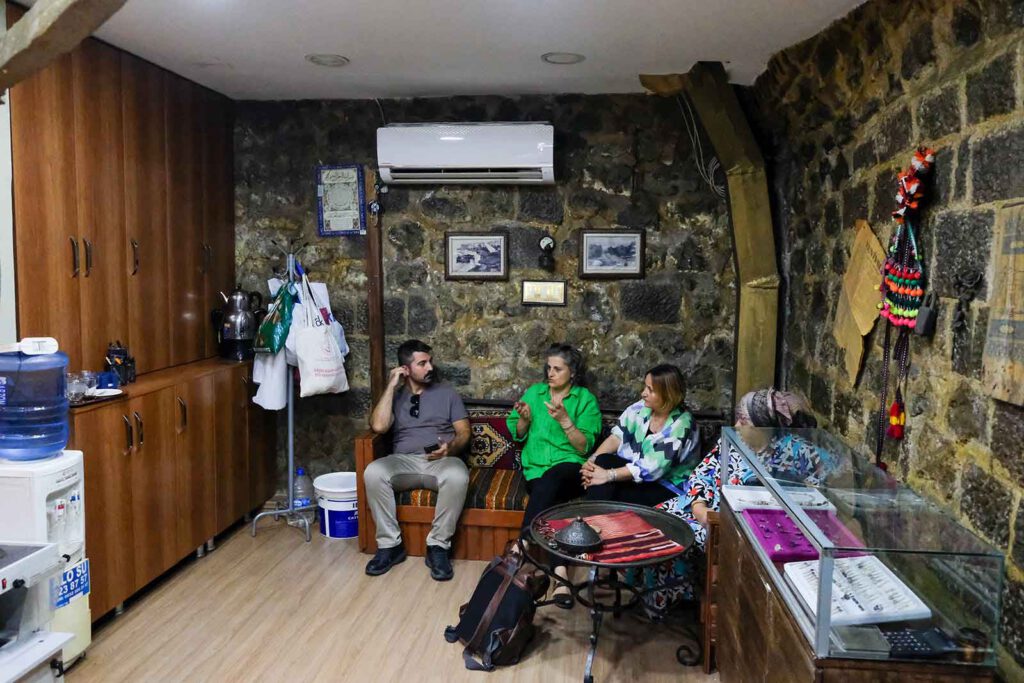
Hasan Tabakoğlu: Kazazlik
Kazazlik is an ancient gold and silversmithing technique; it was the Lydians who exported the cherished jewellery to the entire Mediterranean region, where crowned heads and representatives of the ancient upper class liked to adorn themselves with it.The Lydians first minted electrons and later gold coins with lion heads or lion and bull heads, they were experts in their field.
The reader is certainly familiar with one of the most interesting rulers of the Lydian people: Croesus, who went down in history for his legendary wealth.
The Lydian king drew his treasures from the natural wealth of resources in Asia Minor, and gold from the river Paktolos and in the mines between Atarneus and Pergamon!
The tribute payments from the conquered Greek cities and the tax payments from trade and commerce represented a further source of income.
Although Croesus was relatively rich compared to the number of his citizens, his fortune was not nearly comparable to that of the Persian kings, who could literally bathe in rubies and emeralds, certainly very refreshing!
So even back then it was said: Diamonds are a girl’s best friend!
In the meantime, however, there are only a few masters who are able to produce jewellery in such an elaborate way.
One of them is Hasan Tabakoğlu, who runs his atelier in the old town of Trabzon, well hidden in a passageway in the middle of the busy centre.
For over 50 years, he has been transforming precious stones, gold and silver wire into the finest jewellery, just like his father before him, who once taught him the craft.
Tabakoğlu explains to us how his sublime pendants, necklaces, rings and tiaras are created. Wafer-thin gold and silver wires are twisted into thousands of tiny knots. For every centimetre there are hundreds of these knots, until in the end a gold or silver chain is created that is second to none.
The goldsmith gives a guarantee of 100 years for the chains – that’s quite a claim.
We were allowed to see for ourselves that the structures are practically indestructible, only under the tyres of a 40-tonne truck could damage occur under certain circumstances, according to his comment.
Only silver with a fineness of 1000 and gold with a fineness of 24 carats are used for his work, the finest of the finest!
Each piece of jewellery takes about 7-10 days to make, Tabakoğlu emphasises, pointing out that once the sultans and their consorts in the Ottoman Empire proudly wore Kazaziye jewellery.
The master likes to draw his inspiration from his predecessors in antiquity; some of the elegant pieces can also be seen in the Topkapi and Dolmabahçe residences. Needless to say, the Turkish top jeweller has been showered with awards, but I find that he has nevertheless remained a likeable and modest person, which is not the case for everyone who has achieved such success.
Address:
Kemerkaya mah. Kunduracılar Caddesi Alipaşa Çarşısı no:37 Trabzon/Türkiye
His studio is in a small passage in the old town, not easy to find.

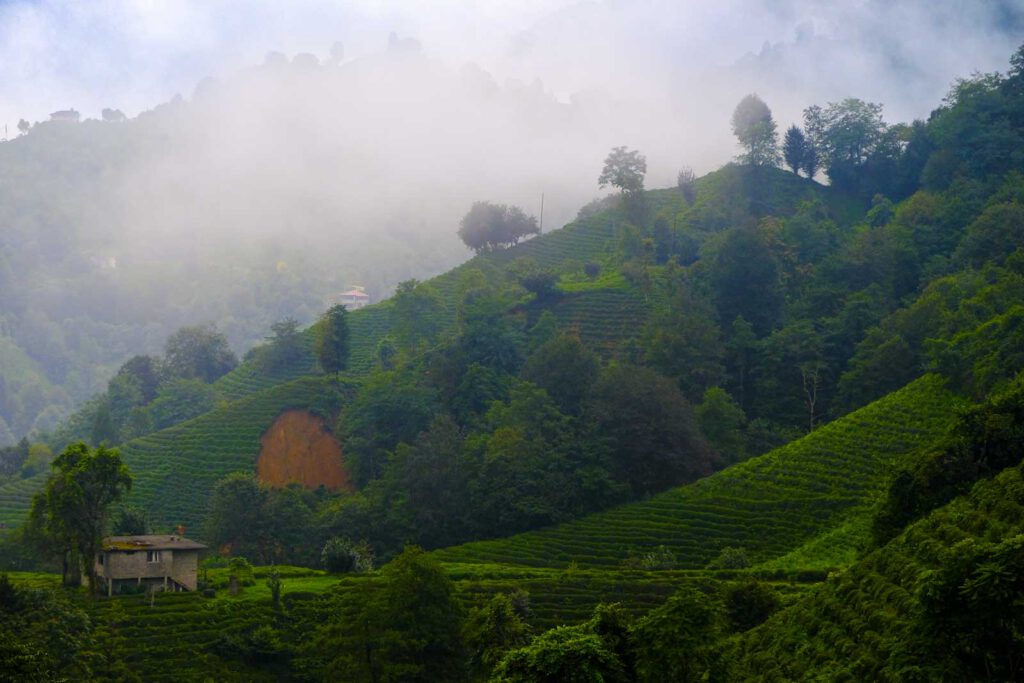

Çay
The Turkish tea tradition is not as ancient as some might think. Until the 19th century, Turkish coffee was the most popular beverage.Coffee was imported until then. After the collapse of the Ottoman Empire, prices exploded and people started looking for alternatives.
First attempts to make tea native to Turkey fail because of the drought. In the 1930s, success was finally achieved in Rize on the Black Sea. The temperate climate of this region is mild and extremely rainy, and the Black Sea Mountains (Turkish: Kaçkar Dağlar) with their high peaks offer excellent conditions for cultivation.
Suddenly, tea is drunk everywhere, mainly black tea.
Today, tea consumption in Turkey beats all records, with an average of 2.8 kg of tea per person annually. As a tea exporting nation, Turkey is still in its infancy and cannot keep up with the huge quantities shipped from India, Sri Lanka and China worldwide.
Usually, the Çay is harvested with tea scissors before the complicated process of fermenting, maturing and sometimes roasting begins.
Particularly fine green teas are harvested and processed by hand until they finally reach the discerning tea consumer.
The tea is drunk from so-called tea tulips, by the way, and is prepared in the caydanlik, a two-storey tea kettle.
There are several harvests, the mildest is the May tea, somewhat spicier and slightly more bitter are the late harvests in July and September.
The region around Rize is not immune to climate change. The plants grow best when it is not too cold at night. In the last two years, the harvest has not been as optimal due to temperature fluctuations, but the tea industry around Rize is and remains the largest employer with about 400,000 employees.

Çaymer, a Tea Tasting
In entire Turkey, about 225-230 thousand tons of tea are produced per year, Rize alone accounts for about 85% of the total production, that’s a word.
A few years ago, there was even a “Tea Taster Training Project” financed by the European Union and the Republic of Turkey; at that time, young unemployed people were introduced to the subject, qualified jobs in the industry are highly wanted!
Such projects are meaningful and serve to promote understanding across borders.
We visit together the Tea Research and Application Centre (ÇAYMER), commissioned in 2018 with a funding of 10 million euros from the European Union and Turkey to keep the tea industry around Rize competitive.
Since then, the integrated, state-of-the-art research laboratory has been providing reliable figures and new knowledge about the Çay.



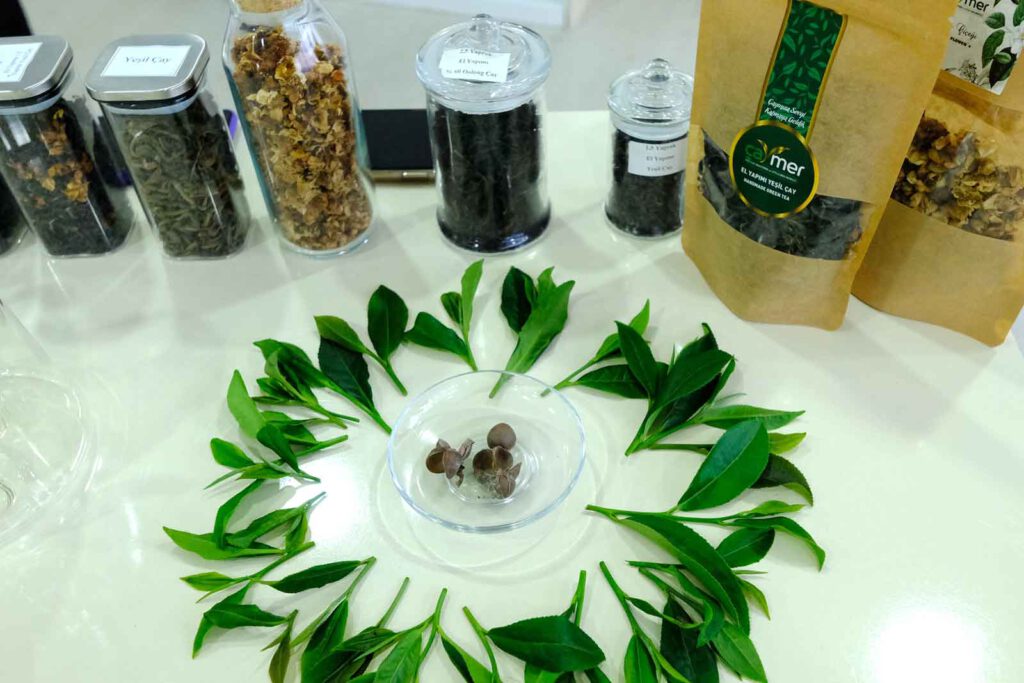

Muhammet Çomoğlu skillfully guides us through the individual steps of tea production, a complex process that requires precision and experience. The individual steps range from storage, heating, fermentation and roasting to packaging.
Finally, a wide variety of Çays must be tested for appearance, aroma, body, flavour and finish.
For appearance, we judge clarity and colour, for aroma, complexity, certain nuances should be present.
Body is about balance and sensation in the mouth. On the palate, for example, wood, smoke, tobacco, vanilla, metal, etc. should be recognised. And finally, the finish, short, long, lingering, echo, no echo, etc.
A good tea tasting and for some of us perhaps the only day on which raki was later preferred.
Enchanted places…






This happens in the Caglayan valley near Fındıklı, where an ancient, tiny settlement of Armenian houses suddenly appears in front of our eyes.
There are a few wooden storehouses built on stilts to keep rodents away.
The weathered wood has seen many generations come and go in over 200 years.
No one is around, a dog is barking somewhere. A pleasant shiver runs down my spine. The scenery is beautiful and creepy at the same time.
The perfect location for a mystery thriller. Who might be living here in the middle of the wilderness?
By the way, there are several hiking trails in the region, especially the paths on the famous plateaus like the Ayder Plateau are popular.
Hikers are best advised to join a group with a guide who knows the area.



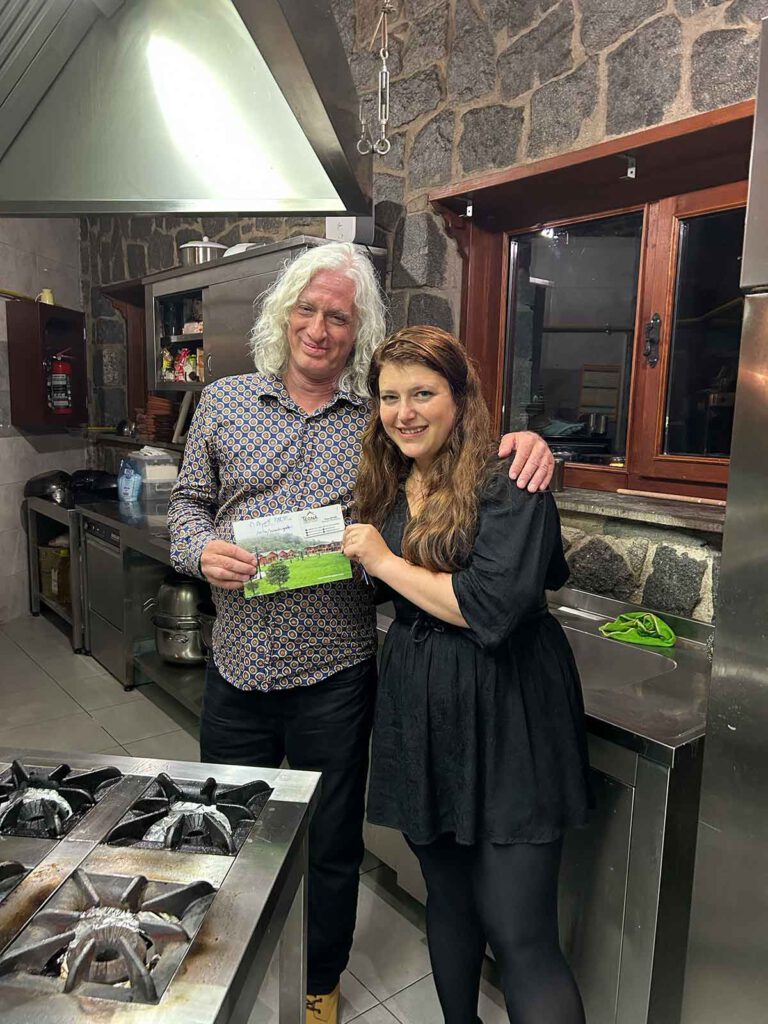


Tip: Nearby are the Teona Bungalows with an attached restaurant. The wooden bungalows offer all useful comforts, the mountain river Büyük flows directly below the window.
You can also go on nice hikes there without a guide.
We ourselves stayed there. The young Aygül Kartal runs the restaurant and the hotel, she is doing a good job!
We had a nice trout in the evening. If I come to the area again, and if Aygül is interested, I will be happy to show her in the spacious kitchen that there are even finer ways of preparing fish, even with the simplest of ingredients.
Of course I recommend the restaurant, you can enjoy regional products, very good cheese, everything freshly prepared, great!
En route to the Gito Plateau
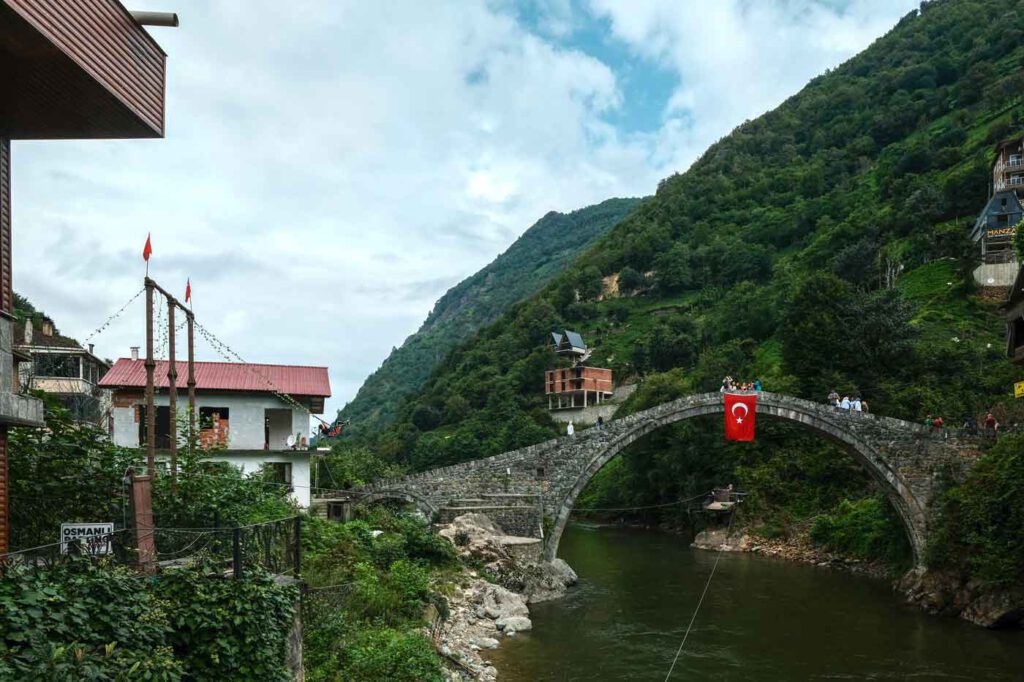










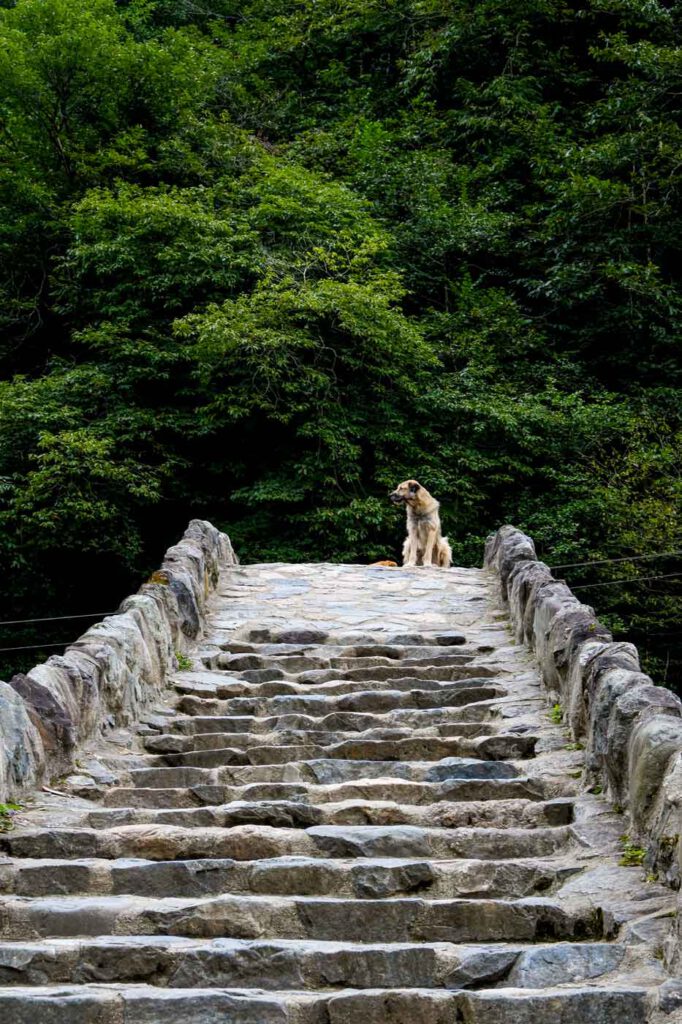
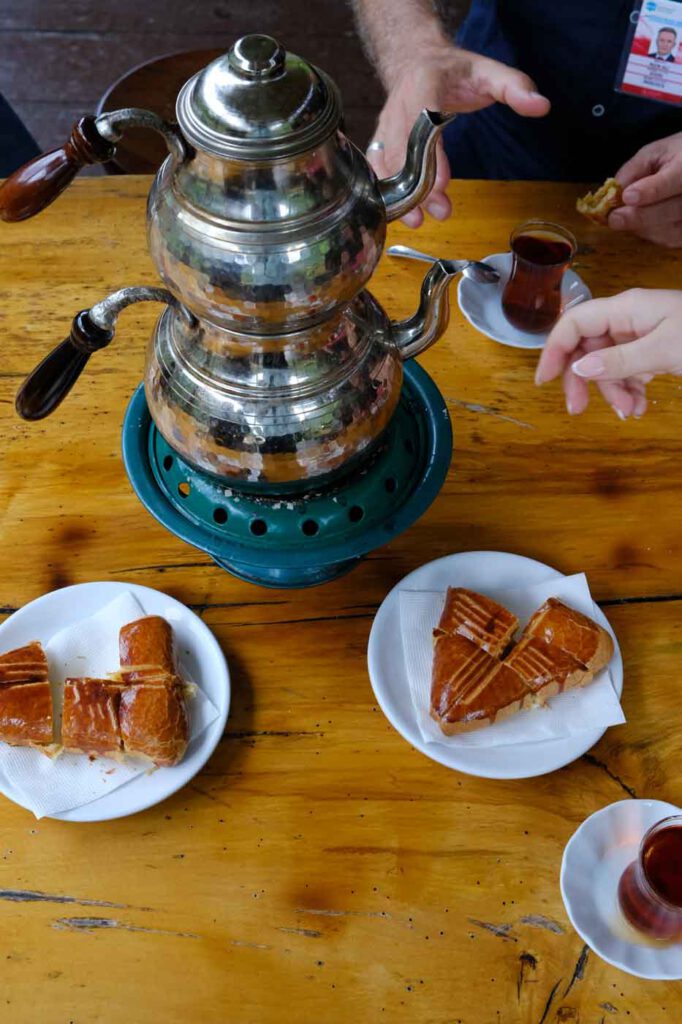
There is a popular phrase in Rize: it rains only twice a week, once from Sunday to Wednesday and once from Thursday to Saturday.
We don’t care and follow the Firtina River towards Zil Kale.
The river has been developed for tourism; if you want to go rafting, this is the right place.
Again and again, filigree arch bridges from Ottoman times span elegantly over the banks.
We pass the village of Şenyuva, where the popular telenovela “Sevdaluk” was filmed a long time ago.
Storyline:
A small community on the shore of the Black Sea has to deal with the problems of daily life, including greedy capitalists who want to take over the land.
Old and young, modern and traditional meet. The centre of the action is, of course, the village café where love affairs begin or end and infamous intrigues are devised along the way, just like in real life, wonderful, telenovelas are a fine invention.
We drink a nice Çay in this café. They serve hazelnut biscuits with it.
Zil Kalesi






The castle is pure Middle Ages.
It was probably built in the 5th-6th century on the edge of a high cliff, about 1200 metres above sea level, as was usual at the time for control and defence purposes.
In Byzantine times a bulwark against attackers from the east.
It is probable that the castle was still important as a checkpoint for caravans in Ottoman times.
The fantastic view alone makes it a great destination! Recommendation!
At some point the road becomes an adventure track, when we finally reach the famous Gito plateau it is raining and the fog obscures the view.
You never know how the weather will turn out in the mountains. While the Sümela monastery was at its best a few days ago, today the Gito Plateau is hidden in thick fog, just like the Ayder Plateau, which is also on the programme, but I will write about that another time.
There are much worse things, dear readers. Our driver personally prepares a wonderful Çay on the mountain and we are also treated to the friendliest of hospitality.
Just like during the whole trip. I have taken the people there into my heart; they know how beautiful their homeland is and are happy to give this feeling to the visitor. They are proud and reserved at the same time, which is charming!


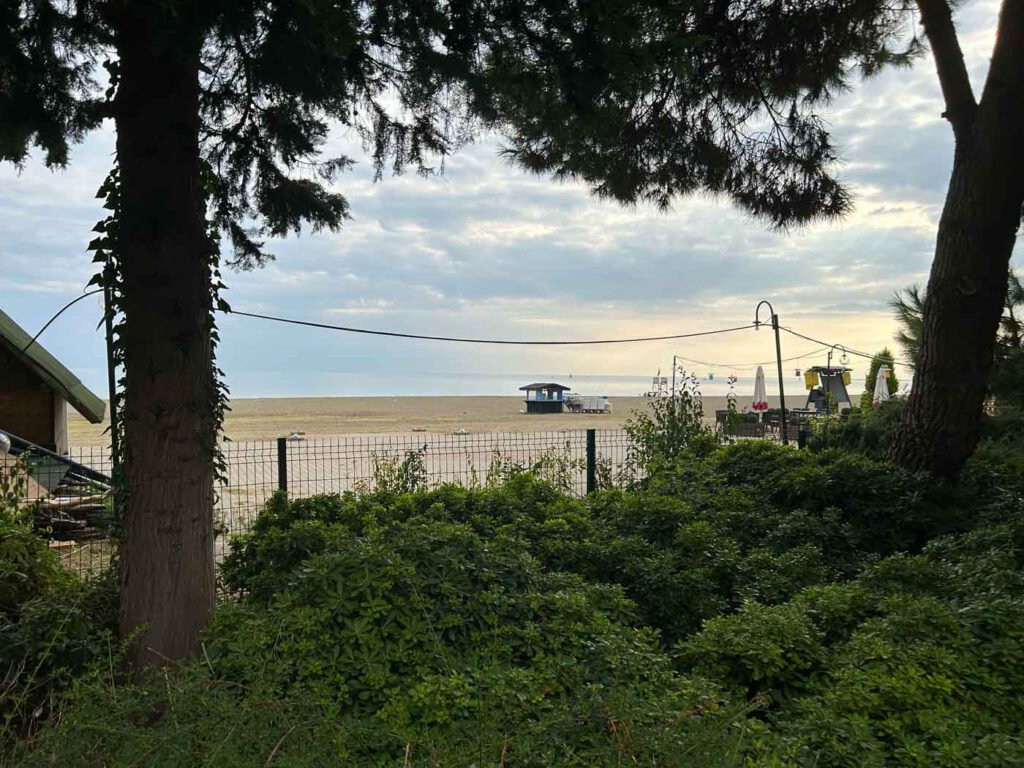
Tips:
Flights to Trabzon are available from many German airports.
For example with Turkish Airlines.
Pegasus even offers some direct flights in the tourist season. However, the connections almost always go via Istanbul.
Hotels:
In the mountains there are beautiful bungalow resorts that emphasise sustainable tourism, like the Teona bungalows recommended in the report.
Rain gear and sturdy shoes are recommended at any time of year, especially when travelling in the mountains.
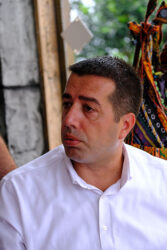
Burak from tamitur is an expert. It will take you safely to all kinds of interesting destinations around Rize.
You will find a lot of infromation at. GoTürkiye.
If you want to know more details, do not hesitate to contact me directly.
Reprinting, integration into digital media of all kinds, including excerpts, only with the express permission of the author. ©grandgourmand/Mathias Guthmann
Nachdruck, Einbindung in digitale Medien aller Art, auch auszugsweise, nur mit ausdrücklicher Genehmigung des Autors. ©grandgourmand/Mathias Guthmann
![[:de]Grandgourmand, Travel, Food, Lifestyle[:]](https://grandgourmand.de/wp-content/uploads/2023/01/logo_23_1-1.png)













